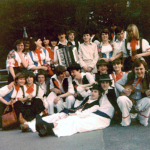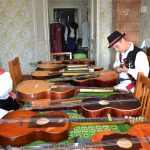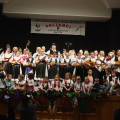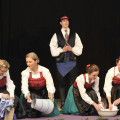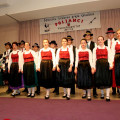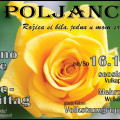Chronicle
In 1977 about 30 young people meet upon the iniciative of mag. Angelika Kornfeind to dance together. A little later Jakob Dobrović with his young musicians, playing the tamburitza, takes over the musical leadership. Mothers of the young members sew the costumes and under the name POLJANCI the group soon begins to gain a fix position in the folk-dance and folk-music scene of Burgenland.
The music and dance programmme is widened and sacral and popular music are included.
For the 10-years’ anniversary a music cassette is published, and for the 20-years’ jubilee a MC/CD, a booklet with music and dance descriptions plus video for beginners and advanced is produced, a booklet with popular and one with sacral songs for tamburitza is published, for the ORF songs for children are recorded, a PowerPoint presentation is designed and a web-site is installed.
In 1988 young tamburitza-players start their training and a children’s group is founded which performs under the name “Small and young POLJANCI”. In 1999 the group gets a choir.
The group regularly performs in Wulkaprodersdorf, the surrounding boroughs and other locations in Austria and acroos the boarder.
In 1992 the training place canges from the church barn to the newly extended elementary school.
In 2002 the group celebrates its 25-years’ anniversary.
During the time the musical leadership moves from Maria Zarits to Gerhard Krumpeck, Ante Pletikosić and finally to Julia Kornfeind and Stefanie Ferschin.
The dance leadership changes from Nikolaus Semeliker, Rudolf Stagl, Günther Guttmann back to Nikolaus Semeliker and finally to Lukas Kornfeind.
From the beginning the members have tried to keep themselves in a good mood and to transport this good mood upon others.
2012: 35th anniversary
Visits to foreign countries:
- 1979: Jugoslavia (Lipovljane)
- 1980: Germany (Gemünden, Laubach), the Netherlands (Lochem)
- 1981: Italy (Gorizia), France (St.Estéve), Switzerland (Winterthur)
- 1983: Italy (Penna S. Andrea)
- 1984: Germany (Gemünden)
- 1985: France (St.Estéve)
- 1988: France (Burgund, Alsace)
- 1990: France (Alsace/Imbsheim), Slovakia (Devinska Nova Ves)
- 1995: Great Britain (Wales/Llangollen-Eisteddfod, London)
- 1997: Belgium (Brüssel, Zedelgem)
- 1999: Lithuania (Palanga, Kaišiadorys)
- 2001: France (Paris, Bretagne/Guimiliau, Bannalec)
- 2002: Ireland (Ennis, Dublin)
- 2004: Romania (Timisoara, Carasova)
- 2006: South Tyrol (Villanders)
- 2008: Lithuania (Klaipéda)
- 2009: Italy (Venice, Rome, Molise Croats)
- 2010: Croatia (Sveti Martin na Muri)
- 2011: Canada/USA (Toronto/New York)
- 2013: Germany (Dresden, Bautzen / Lusatian Sorbs)
- 2014: Germany (Munich)
- 2015: Hungary (XII. St Stephen’s International Folk Dance Festival, Abony-Szolnok-Cegléd)
- 2016: Czech Republic (XXII. International Folk-festival Pisek)
- 2017: Bosnia and Hercegowina and Serbia (Dolac on the Lašva and Tavankut)
- 2019: France & Italy (World Folklore Festival Diano Marina, San Remo, Cannes)
- 2023: Montenegro (Internationa Folklore Festival Budva)
- 2024: Croatia(Đakovački Vezovi)
Summer holidays in Croatia:
- 1982: Rabac/Istria
- 1986: Baška/Krk
- 1987: Nerežišće/Brač
- 1989: Dubrovnik/Southern Dalmatia
- 2000: Krk/Krk
- 2005: Stobreč-Split/Dalmatia





